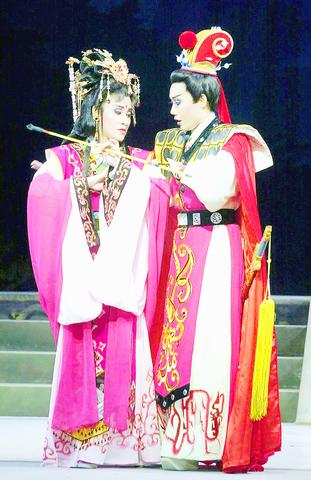The Taiwan session of the "2001 forum of cross-strait exchanges on Taiwanese Opera Development'' closed on Sept. 4 in Ilan, and the China session will begin in Zhangzhou (
As during previous seminars dealing with the issue, the debate over where Taiwanese Opera originated was inconclusive.

PHOTO: CHIANG YING-YING, TAIPEI TIMES
The Forum was organized by the Council for Cultural Affairs.

PHOTO: COURTESY OF YANG LI-HUA'S WEB SITE
Ilan-origin Theory
Scholars and researchers from both sides of the Strait agree that Kim Kua (錦歌), introduced by migrants from Zhangzhou to Tai-wan, during the Ming and Qing Dynasties, is the earliest form of Taiwanese Opera.
Researchers from China and Taiwan also acknowledge that Taiwanese Opera was greatly influenced by Peking Opera. During the 1910s, Peking Opera troupes from Shanghai and Fuzhou frequently came to perform in Taiwan. Some members of Peking Opera troupes later joined Taiwanese Opera troupes as opera directors or trainers.
Lin Mao-hsien (林茂賢), professor of the Department of Chinese Literature at Providence University, presented a paper based on the Ilan theory titled, "A study on local ballad" at the forum. Ilan theory suggests that Taiwanese Opera evolved from a minor form of opera called "Lo-deh Sao" (
According to Lin's paper, Tai-wanese Opera originated in Ilan. Lin cites three texts to support his argument. The paper notes that both the Annals of Ilan County and the Annals of Taiwan Province say that Taiwanese Opera originated in Ilan and that performances of Taiwanese Opera in Ilan had been reported in the Aug. 15, 1905 issue of the Taiwan Jih Jih Shin Po. In addition, Lo-deh Sao is still performed in Ilan
If Lin's theory is correct, Taiwanese Opera initially began as traditional ballad singing and then transformed into Lo-deh Sao; generally rendered by two or three singers and accompanied by a few musicians playing local instruments.
The plays took place for the most part at public squares in the countryside, in the courtyards of temples during ceremonies or in street parades. After Lo-Deh Sao absorbed performing styles and techniques from major operatic forms such as Chia-ko Lang (車鼓弄) and Ke-ka (高甲) and adopted instruments such as drums and gongs, it became a sophisticated opera in its own right, performed on stage.
Although doubts about Ilan theory have been raised within academic circles over the past 20 years, Ilan theory seems to have become widely accepted. A documentary by the National Taiwan Junior College of Performing Arts,which set up its own Taiwanese Opera department in 1994, credits Lo-deh Sao as the predecessor of Taiwanese Opera.
"Yes, we credit Lo-deh Sao as the original type of Taiwanese Opera because Ilan theory is well established and widely recognized," Lin Sien-yuan (林顯源), director of the department of Taiwanese Opera, told the Taipei Times.
The Council for Cultural Affairs also credits Ilan as the homeland of Taiwanese Opera, not only through organizing the forum in Ilan, but also by planning to set up the National Center for traditional arts in Ilan county.
Even Chinese scholars support Ilan theory. When commenting on Lin's paper at the forum, Chen Keng (
Tseng Shuehren (
"Before new evidence is found, Ilan theory has its logic. Taiwanese Opera is based on ballads from the mainland and adopted native Taiwanese music and folk tunes. It then developed into Taiwanese Opera," Tseng told the Taipei Times.
Skepticism in academic circles
One of the main challengers of Ilan theory, Lin ho-yi (
"Since Lo-deh Sao still exists in Ilan, while Taiwanese Opera has reached its peak and declined in the west [western Taiwan], apparently they are two different things," Lin ho-yi told the Taipei Times.
"Besides, the two annals on which Ilan theory is based were published quite recently. One was published in 1963 and the other in 1970. The conclusions based on the two annals were arrived at by a group of advocates of local historical research from Ilan," Lin ho-yi said.
"Certainly, Ilan theory is possible. It could be also possible that Taiwanese Opera evolved directly from ballad singing and by absorbing musical, performing, technical and artistic elements from other major forms of opera. From the point of view of the evolution of opera, the transformation of Taiwanese Opera did not have to go through a minor form of opera like Lo-deh Sao," Lin Ho-yi concluded.
Wang Shih-i (王士儀), professor of the department of Chinese drama at Chinese Cultural University, is even more critical, raising the theory that Taiwanese Opera came from Tataocheng (大稻埕) in Taipei.
"Economically, Ilan is too isolated to play such a major cultural role. How could such a poor district have the ability to influence the popularity of Taiwanese opera? Only an economically prosperous area could play such a role," Wang told the Taipei Times.
According to Wang's field study, Taiwanese Opera took place on a stage in front of a temple at Tataocheng and Ka-tzau Sien (
"Ka-tzau Sien was dancing Chia-ko Lang and replaced the spoken dialogue with singing, to escape official censorship. The flirting style of Chia-ko Lang was seen by the Japanese authorities as licentious," Wang said.
"Master Lee was already 12 years old when he witnessed the performance by Ka-tzau Sien in 1923, and he told me in person that Ka-tzau Sien was Tan Ka-tzau (陳嘉走) from Hsinchuang (新莊), instead of Tan Sum-gi (陳三儀) from Ilan."
Ka-tzau Sien is said to be the first theater director of Taiwanese Opera. Some believe Ka-tzau Sien was actually Tan Sum-gi.
Lau Siu-teng (
"In my field studies, I found some very old performing styles with similar costumes and music to the local ballads of Ilan. It means the same thing also existed in the west. The fact that Lo-deh Sao is still performed in Ilan only demonstrates the conservative character of Ilan," she said.
Taking History Seriously
With Taiwanese Opera gradually losing its audience, academics and young intellectuals are worried about its survival. In order to save a performing art so dear to Taiwanese society, some young intellectuals devote their time to research and performance.
In February of last year, the first Taiwanese Opera to narrate the love story of a young Han immigrant from China with an Aboriginal girl of the Ping-pu tribe was brought to the stage at the National Theater. The opera, roughly translated as When the Carol Tree Blossoms (
"Beforehand, Taiwanese Opera depicted only ancient Chinese stories and had never seriously dealt with Taiwanese history. Since Taiwanese Opera is a native [pre-World War II] performing art, we should add more localized elements into the play," Lao said, commenting on the new opera.
Script writer Yang Sing-chi (
Before Han immigrants began to arrive in Taiwan, the Ping-pu were indigenous people who lived on the western plains and along the western coast.
Dubbed "ripe savages" by Han immigrants, the Ping-pu were peasants and fishermen who lived on the plains -- in contrast to people living in mountainous areas, who were known as "raw savages."
Since Han immigrants were mostly desperate and unmarried, many young Han men intermarried with the Ping-pu in order to exploit the tribe's land and property.
The social structure of the Ping-pu tribe met the ambitions of Chinese immigrant bachelors perfectly.
To marry a Ping-pu woman was an obvious solution for most of these immigrants. The Ping-pu tribe was a matriarchal society in which property was inherited by the daughter.
Through cultural interaction and interracial marriages, the Ping-pu tribe finally disappeared in the early 20th century. The blossoming of the carol trees were used by the Ping-pu as a functioning calendar to mark the beginning of another year.
The eternal star
During the 1970s it was a national pastime to watch TV when Taiwanese Opera programs aired.
In the Qing Dynasty, women were forbidden by law to perform on stage. All roles in the opera were played by men. After 1911, women quickly replaced men and dominated the stage.
The real stars in a troupe are the female performers who play the lead male roles. These women are usually slim and have deep voices.
Among all of the opera performers who have appeared on TV, perhaps the most famous was Yang Li-hua (楊麗花), who has studied Taiwanese Opera since his childhood.
In 1983, she married orthopedist Hong Wen-tong (洪文棟), who later became a legislator. When the wedding ceremony took place at the Grand Hotel, the hotel was filled with celebrities, invited guests and crowds of fans.
One of the presiding witnesses was then-provincial governor and now retired president Lee Teng-hui (李登輝).

The US government has signed defense cooperation agreements with Japan and the Philippines to boost the deterrence capabilities of countries in the first island chain, a report by the National Security Bureau (NSB) showed. The main countries on the first island chain include the two nations and Taiwan. The bureau is to present the report at a meeting of the legislature’s Foreign Affairs and National Defense Committee tomorrow. The US military has deployed Typhon missile systems to Japan’s Yamaguchi Prefecture and Zambales province in the Philippines during their joint military exercises. It has also installed NMESIS anti-ship systems in Japan’s Okinawa

TRAGEDY STRIKES TAIPEI: The suspect died after falling off a building after he threw smoke grenades into Taipei Main Station and went on a killing spree in Zhongshan A 27-year-old suspect allegedly threw smoke grenades in Taipei Main Station and then proceeded to Zhongshan MRT Station in a random killing spree that resulted in the death of the suspect and two other civilians, and seven injured, including one in critical condition, as of press time last night. The suspect, identified as a man surnamed Chang Wen (張文), allegedly began the attack at Taipei Main Station, the Taipei Fire Department said, adding that it received a report at 5:24pm that smoke grenades had been thrown in the station. One man in his 50s was rushed to hospital after a cardiac arrest

‘WIN-WIN’: The Philippines, and central and eastern European countries are important potential drone cooperation partners, Minister of Foreign Affairs Lin Chia-lung said Minister of Foreign Affairs Lin Chia-lung (林佳龍) in an interview published yesterday confirmed that there are joint ventures between Taiwan and Poland in the drone industry. Lin made the remark in an exclusive interview with the Chinese-language Liberty Times (the Taipei Times’ sister paper). The government-backed Taiwan Excellence Drone International Business Opportunities Alliance and the Polish Chamber of Unmanned Systems on Wednesday last week signed a memorandum of understanding in Poland to develop a “non-China” supply chain for drones and work together on key technologies. Asked if Taiwan prioritized Poland among central and eastern European countries in drone collaboration, Lin

ON ALERT: Taiwan’s partners would issue warnings if China attempted to use Interpol to target Taiwanese, and the global body has mechanisms to prevent it, an official said China has stationed two to four people specializing in Taiwan affairs at its embassies in several democratic countries to monitor and harass Taiwanese, actions that the host nations would not tolerate, National Security Bureau (NSB) Director-General Tsai Ming-yen (蔡明彥) said yesterday. Tsai made the comments at a meeting of the legislature’s Foreign Affairs and National Defense Committee, which asked him and Minister of National Defense Wellington Koo (顧立雄) to report on potential conflicts in the Taiwan Strait and military preparedness. Democratic Progressive Party (DPP) Legislator Michelle Lin (林楚茵) expressed concern that Beijing has posted personnel from China’s Taiwan Affairs Office to its